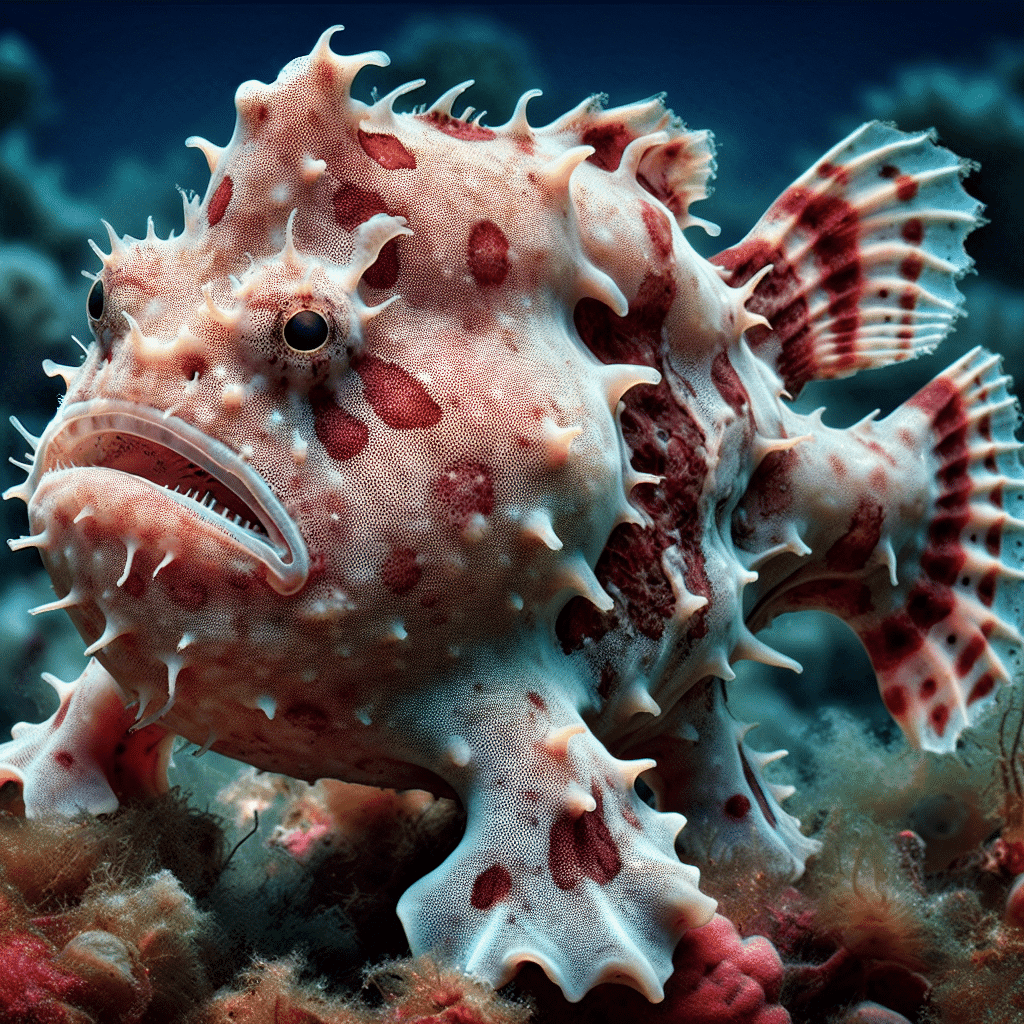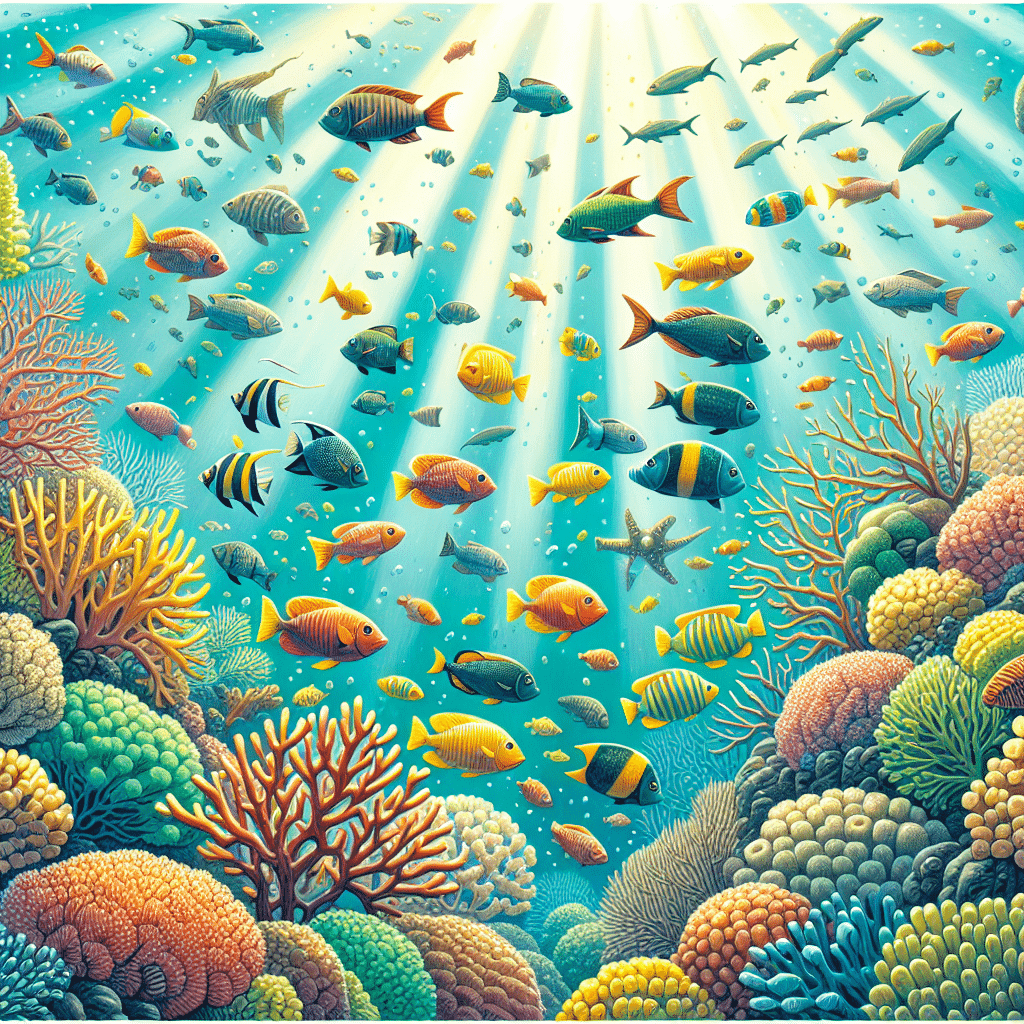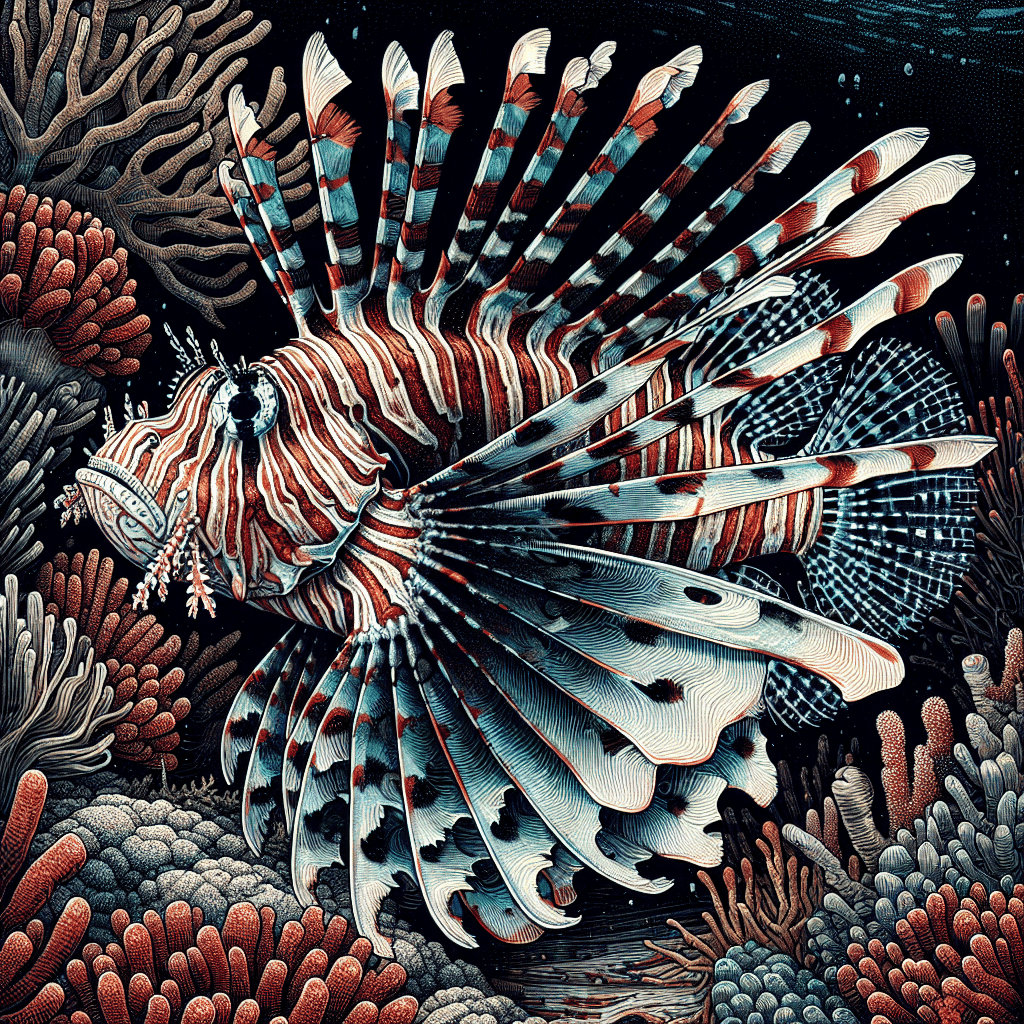Discovering Frogfish
Habitat and Distribution
I’ve always been fascinated by frogfish, and their habitat is just as intriguing. These unique creatures inhabit almost all tropical and subtropical oceans around the world, with the notable exception of the Mediterranean Sea. They thrive in various environments, including the Atlantic, Pacific, Indian Ocean, and the Red Sea. The greatest diversity of frogfish species can be found in the Indo-Pacific region, particularly around Indonesia (Wikipedia).
Frogfish prefer to dwell in shallow waters, often hiding in coral reefs, rocky crevices, or among seaweed. Their excellent camouflage allows them to blend seamlessly into their surroundings, making them difficult to spot for both predators and prey.
| Region | Presence |
|---|---|
| Atlantic Ocean | Yes |
| Pacific Ocean | Yes |
| Indian Ocean | Yes |
| Red Sea | Yes |
| Mediterranean Sea | No |
Physical Characteristics
When it comes to physical characteristics, frogfish are quite distinctive. They have a stocky appearance, generally ranging from 2.5 to 38 cm (0.98 to 14.96 inches) in length. Their bodies are plump and high-backed, often covered with bumpy, bifurcated spinules that enhance their camouflage capabilities (Wikipedia).
Frogfish have short, unstreamlined bodies with upward-pointed mouths and palatal teeth, which help them capture prey effectively. Their vibrant colors often mimic the coral and the environment they inhabit, which is essential for their survival.
| Characteristic | Description |
|---|---|
| Length | 2.5 – 38 cm (0.98 – 14.96 in) |
| Body Type | Stocky and plump |
| Skin | Scaleless, covered in spinules |
| Mouth | Upward-pointed |
| Coloration | Brightly colored for camouflage |
Getting to know frogfish can really enhance your aquarium experience. If you’re considering adding one to your tank, understanding their habitat and physical traits is a great start. For more on marine fish, check out our guide on marine fish and other fascinating species like lionfish and clownfish.
Behavior and Feeding Habits
Frogfish are fascinating creatures with some unique feeding habits that make them stand out in the reef tank. Their behavior, particularly their luring techniques and predation strategies, is quite remarkable and worth exploring.
Luring Techniques
Frogfish are masters of disguise when it comes to catching their meals. They use a strategy known as aggressive mimicry to lure in prey like fish and crustaceans. By mimicking food items such as worms, small shrimp, or tiny fish, they attract unsuspecting prey to their vicinity. Once the prey is close enough, the frogfish strikes quickly, engulfing it whole.
Depending on their environment, frogfish adapt their luring techniques. For instance, those living on sandy substrates may have lures that are designed to stay close to the ground to entice benthic animals. In contrast, frogfish residing among sponges or corals often lure prey from a higher position. Each species has its own unique pattern of movement for its lure, which plays a crucial role in attracting potential meals (Frogfish).
Prey and Predation
When it comes to eating, frogfish have an impressive ability to consume prey that is twice their size. They achieve this through a process known as “gape and suck,” which is incredibly fast—taking only about six-thousandths of a second. To do this, they expand their oral cavity by lowering their lower jaw and stretching their upper jaw, creating suction that pulls the prey in (Frogfish).
These fish generally prefer to remain stationary, waiting for the right moment to strike. They exhibit slow and deliberate movements, which helps them blend into their surroundings while they hunt. In open water, they can swim using their caudal fin, but they mainly rely on their unique adaptations and camouflage to ambush prey.
Here’s a quick overview of the frogfish’s feeding characteristics:
| Feeding Characteristic | Description |
|---|---|
| Luring Method | Aggressive mimicry |
| Prey Size | Up to twice their size |
| Feeding Speed | 6 milliseconds for “gape and suck” |
| Movement Style | Slow and deliberate |
Frogfish are truly fascinating in their approach to hunting and feeding. If you’re interested in keeping a frogfish in your reef tank, understanding their behavior can help ensure they thrive in your aquarium environment. Be sure to check out more about marine fish and their care to create a suitable habitat!
Frogfish Family
Understanding the frogfish family is essential for any aquarium enthusiast interested in these unique creatures. The frogfish belong to the family Antennariidae, which was first proposed in 1822 by Polish zoologist Feliks Paweł Jarocki. This family is classified within the suborder Antennarioidei and the order Lophiiformes, commonly known as anglerfishes (Wikipedia).
Taxonomy and Classification
The classification of frogfish can get a bit intricate. The family Antennariidae is recognized to have 13 genera, although no subfamilies are officially designated. One of the most well-known genera is Antennarius, first proposed in 1816 by French naturalist François Marie Daudin. The type species for this genus, Lophius chironectes, was designated in 1856 by Pieter Bleeker.
Frogfish are characterized by several distinct features, which include a unique esca or lure on the illicium, a movable third dorsal spine, a small round gill opening, and limb-like pectoral fins that resemble elbows. Additionally, they have short pelvic fins with five fin rays—four simple and one branched (Wikipedia).
| Classification Level | Name |
|---|---|
| Family | Antennariidae |
| Suborder | Antennarioidei |
| Order | Lophiiformes |
Species Diversity
Within the Antennariidae family, there are various recognized species of frogfish. These species exhibit a diverse range of colors and patterns, making them a fascinating addition to any reef tank. Here are some notable species of frogfish:
| Frogfish Species | Common Name |
|---|---|
| Antennarius commerson | Commerson’s Frogfish |
| Antennarius maculatus | Spotted Frogfish |
| Antennarius striatus | Striped Frogfish |
| Antennarius dromeus | Black Frogfish |
| Antennarius guttatus | Guttatus Frogfish |
Each species has its unique adaptations, making them suitable for different environments in your aquarium. Understanding the diversity among frogfish can help with care and habitat setup, ensuring a thriving environment for these captivating fish. For more information on marine fish care, check out our section on marine fish.
Reproduction and Life Cycle
Egg Production
Frogfish are fascinating when it comes to reproduction. Female frogfish can produce an impressive number of eggs, ranging from 40,000 to 180,000 at one time. This high output is particularly interesting as it makes the eggs slightly buoyant. During the mating process, the male nudges the female until she’s ready, and together they swim to the surface. At this point, she releases her eggs, which are attached to a buoyant mass of mucus known as an epipelagic egg raft (Lembeh Resort, Rich Coast Diving). This unique reproductive strategy ensures that the eggs float in the water column, providing them some protection from predators.
Larval Development
Once the eggs hatch, the resulting larvae are quite remarkable. They appear as fully formed miniatures of adult frogfish but lack the developed lure that adult frogfish use for hunting. Interestingly, juvenile frogfish often display different colorations compared to their mature counterparts, which helps them blend into their surroundings and evade predators. Frogfish spend time in their larval stage before they start to develop their unique hunting adaptations (Lembeh Resort).
Understanding the reproduction and life cycle of frogfish can enhance my appreciation for these unique creatures. If you’re interested in keeping frogfish in your tank, knowing about their reproductive habits can inform your care and maintenance strategies. For more information on the general care of marine fish, check out our article on marine fish.
Interesting Frogfish Facts
Frogfish are fascinating creatures with some truly unique traits that make them stand out in the marine world. Here are a couple of interesting facts about their camouflage abilities and unique adaptations.
Camouflage Abilities
Frogfish are masters of disguise, possessing the incredible ability to mimic their surroundings in both form and color. They can change colors to blend in with their environment, although this transformation is not instantaneous; it can take days or even weeks for them to adjust fully (Lembeh Resort). This remarkable skill helps them avoid predators while also aiding in their hunting strategy.
| Camouflage Feature | Description |
|---|---|
| Color Change | Takes days or weeks to adapt to surroundings |
| Mimicry | Blends in with seaweed, coral, and other marine life |
Unique Adaptations
Frogfish have evolved a variety of unique adaptations that enhance their survival in the ocean. One of these is the development of specialized fins that allow them to grasp strands of sargassum, which helps them navigate through seaweed effectively. They can “climb” through this vegetation, making it easier for them to hide and ambush prey.
Younger frogfish may employ a different method of movement, utilizing jet propulsion by rhythmically gulping water and expelling it through their gill openings. This technique allows them to move quickly when necessary (Rich Coast Diving).
Additionally, some species have a small white skin flap or knob located above their mouth. This flap acts as an enticing lure for small animals, attracting them closer to the frogfish’s mouth, where they can then be captured.
| Adaptation | Purpose |
|---|---|
| Grasping Fins | Navigate through seaweed and ambush prey |
| Jet Propulsion | Quick movement for younger frogfish |
| Lure Flap | Attracts prey to facilitate feeding |
These adaptations and camouflage abilities not only make frogfish incredible hunters but also highlight their unique place in the marine ecosystem. If you’re interested in learning more about other marine species, check out articles on marine fish like the lionfish or seahorse.
Care and Maintenance
Caring for frogfish in a home aquarium requires some specific considerations to ensure they thrive. Here’s what I’ve learned about setting up their environment and their feeding requirements.
Tank Setup
When it comes to setting up a tank for frogfish, I recommend a few key points to keep in mind:
- Tank Size: A minimum of 30 gallons is ideal. Frogfish can grow quite large, and they need space to move and to accommodate their unique swimming style.
- Substrate: A sandy substrate is preferable. It allows them to mimic their natural habitat where they can hide and blend in.
- Decor and Hiding Spots: Frogfish are masters of camouflage, so include plenty of rocks, corals, and plants where they can hide. This not only keeps them stress-free but also encourages their natural behavior.
- Water Parameters:
- Temperature: 72°F to 78°F
- pH: 7.8 to 8.4
- Salinity: 1.020 to 1.025 specific gravity
- Filtration: A good quality filtration system is essential to maintain water quality. Frogfish are sensitive to changes in their environment, so consistent water conditions are crucial.
| Parameter | Ideal Range |
|---|---|
| Temperature | 72°F – 78°F |
| pH | 7.8 – 8.4 |
| Salinity | 1.020 – 1.025 |
| Tank Size | Minimum 30 gallons |
Feeding Requirements
Feeding frogfish can be quite entertaining due to their unique feeding habits. Here’s what you need to know:
- Diet: Frogfish are carnivorous and primarily eat live foods. They enjoy consuming small fish, crustaceans, and even larger prey that can fit in their mouths.
- Feeding Frequency: I typically feed them every 2-3 days, ensuring they have enough time to digest their meals.
- Feeding Method: Some hobbyists use a feeding stick or a long tweezers to place food in front of them, which can stimulate their natural hunting behavior. Frogfish have extremely flexible stomachs, allowing them to swallow prey up to twice their size, so it’s important to provide appropriately sized food.
| Food Type | Frequency |
|---|---|
| Live Fish | Every 2-3 days |
| Crustaceans | Every 2-3 days |
| Prepared Foods | Occasionally |
As a frogfish owner, I ensure my tank is well-maintained and that I provide a varied diet to keep my fish healthy and happy. For more information on other types of fish suitable for reef tanks, check out our articles on marine fish like clownfish and lionfish.
Breeding Frogfish
Breeding frogfish can be quite fascinating, especially given their unique reproductive behaviors. Understanding how these fish mate and the challenges they face can help me appreciate them even more as a part of my reef tank.
Reproductive Behavior
Frogfish reproduction is generally characterized by free-spawning behavior, where females release their eggs into the water and males fertilize them. Female frogfish can produce an impressive number of eggs, ranging from 40,000 to 180,000 at one time. This is significant because it makes the eggs slightly buoyant. During mating, the male nudges the female until she is ready, and they swim to the surface together. Here, the female releases her eggs attached to a buoyant mass of mucus known as an epipelagic egg raft (Lembeh Resort).
The exact details of frogfish reproductive behavior, especially for solitary species, are still largely understudied. Most of what we know comes from observations, and there is still more to learn about their mating rituals and habits (Rich Coast Diving).
Challenges and Considerations
Breeding frogfish in an aquarium setting can present several challenges. One of the primary considerations is ensuring the right conditions for spawning. Since frogfish are often solitary, finding compatible mates can be tricky. Additionally, creating an environment that mimics their natural habitat is essential for encouraging breeding behaviors.
Another challenge is managing the large number of eggs produced. While many may hatch, not all will survive due to predation and environmental factors. It’s crucial to provide a safe space for the eggs and later the larvae, as they are vulnerable during their early stages of life.
When caring for frogfish, it’s also important to provide a varied diet to promote health and vitality, which can impact their reproductive success. Keeping the tank clean and ensuring good water quality will help support breeding efforts.
If you’re interested in learning more about other marine fish, check out our articles on various species like lionfish and clownfish.
Conservation Efforts
Threats to Frogfish
Frogfish face several threats that can significantly impact their populations. One of the primary threats is habitat destruction, which often results from coastal development, pollution, and climate change. Coral reef degradation directly affects the ecosystems where frogfish thrive, leading to a decline in their natural habitats.
Overfishing is another major concern, as frogfish are sometimes caught unintentionally in nets meant for other species. Their unique feeding habits can make them susceptible to being captured, further threatening their survival. Additionally, as their prey, such as crustaceans and smaller fish, is depleted due to overfishing, frogfish may struggle to find adequate food sources.
| Threat Type | Description |
|---|---|
| Habitat Destruction | Coastal development and pollution |
| Overfishing | Unintentional capture in fishing nets |
| Prey Depletion | Decreased availability of food sources |
Conservation Initiatives
To address these threats, various conservation efforts are being implemented. Organizations and researchers are actively working to monitor frogfish populations and their habitats, aiming to raise awareness about their ecological importance. Marine protected areas (MPAs) are being established to provide safe havens for frogfish and other marine life, allowing ecosystems to recover and flourish.
Education and outreach programs are crucial in informing fish tank and reef tank hobbyists about sustainable practices. Promoting responsible fishing and habitat conservation can help ensure that frogfish populations remain stable. Efforts are also being made to involve local communities in conservation initiatives, fostering a sense of responsibility towards preserving their marine ecosystems.
For more information about marine fish and conservation efforts, check out related articles like marine fish and lionfish to learn about other species facing similar challenges. By understanding the threats frogfish face and supporting conservation initiatives, I can contribute to the preservation of these unique creatures and the delicate balance of their ecosystems.



